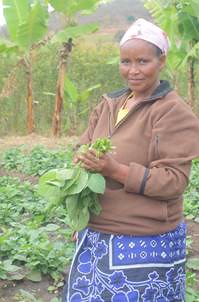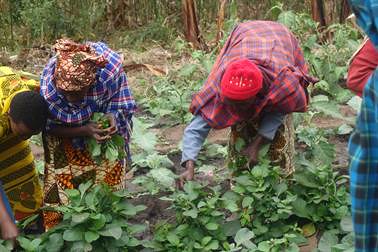A healthy veggie revolution growing in Tanzania

When Omary Poputo tasted the African nightshade for the first time, he said: “I have neither seen nor tasted this vegetable before, but for sure it is definitely one of the best leafy vegetables I have ever tried.”
Omary hails from Sunya village located in Kiteto District, central Tanzania and is one among the 152 lead farmers spearheading a nutritious veggie revolution in this rural community in central Tanzania with the help of staff working on the Africa RISING – NAFAKA and TUBORESHE CHAKULA scaling project funded by USAID.
Through the project, farmers in nine villages located in Manyara and Dodoma regions of Tanzania have been introduced to Amaranth and African nightshade farming.
From the 152 initial vegetable farmers who were trained by the project as “lead farmers”; the project has had a multiplier effect and in the process attracted nearly five times the number of initial farmers in both regions to start growing Amaranth and African nightshade. Currently over 650 farmers are engaged in growing these two nutritious vegetables.
Why Amaranth and African nightshade? The two vegetables are much richer in Vitamin A and micronutrients like iron than the most wide-spread leafy vegetables in Tanzanian villages like the Chinese cabbage and Ethiopian mustard. Deficiencies of in particular Vitamin A can cause night blindness for adults and may reduce bone growth for children. Increasing the intake of Vitamin A is therefore an important objective in Africa in general and Tanzania in particular. According to UNICEF one third of children under the age of 5 are vitamin A deficient in Tanzania and conversely 130 children die every day in the country because they are malnourished.

For Omary, it is the sweet taste of the nightshade variety called ‘Nduruma’ that convinced him this was a good vegetable variety that could be enjoyed by all in the family; especially children under five years who require high Vitamin A intake. Farmers on the other hand appreciate the drought tolerance abilities of ‘Nduruma’.
Omary notes that: “this high drought tolerance capability coupled with the lovely taste enables ‘Nduruma’ to become a variety that might just soon replace other more popular but less nutritious vegetable varieties”.





Latest Comments